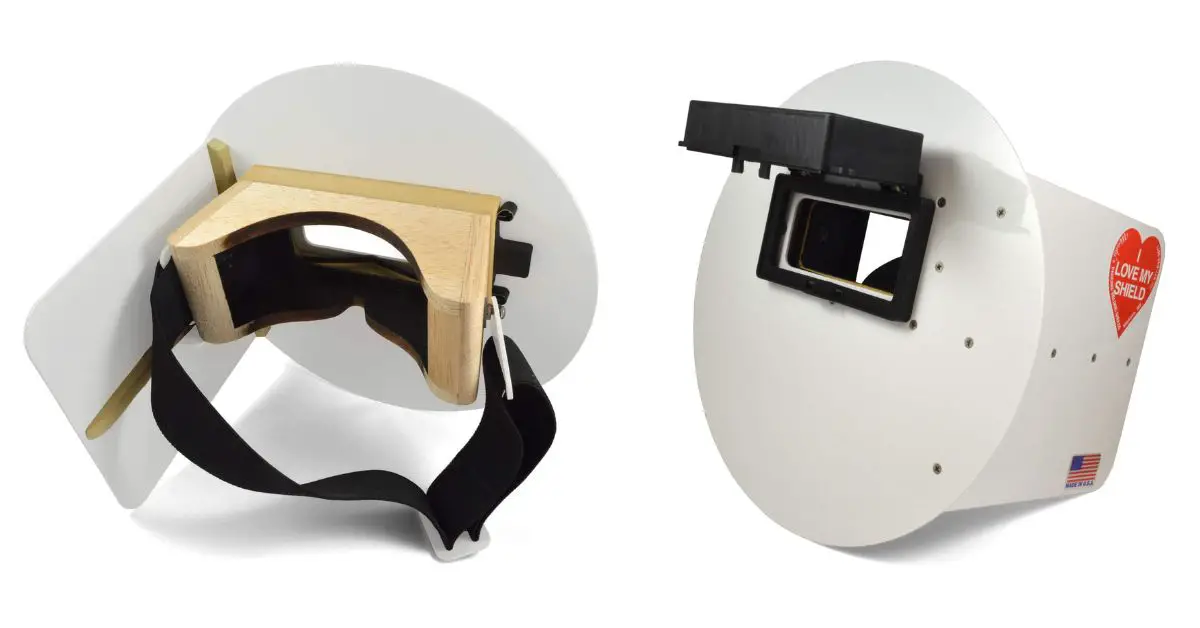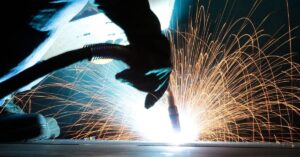In the world of welding, having the right equipment is crucial to ensure safety and efficiency. And one piece of protective gear that every welder needs is a pancake welding hood. But what exactly is a pancake welding hood, and why is it so important?
Its ease of use, lightweight, and the elimination of glare inside the hood makes it a good choice for welders. Unfortunately, many home and hobby welders are unfamiliar with the pancake hood. In this article, we explain what a pancake welding hood is, its benefits, and the different types available.
What is a Pancake Welding Hood?
A Pancake welding hood is a specialized piece of safety gear designed to protect welders from the harmful radiations, sparks, and intense brightness produced during the process of welding.
These hoods not only ensure safety but also provide a clear vision of the welding arc and the surrounding work environment, enabling welders to perform their duties efficiently.
Different types of pancake welding hoods are available, each catering to specific welding needs and providing unique benefits. Whether you’re a professional welder or an enthusiast, investing in a well-made pancake hood is paramount to ensuring safety whilst delivering quality work.
Advantages of using a Pancake Welding Hood
Exceptional Comfort
One primary benefit of a Pancake Welding Hood is its exceptional comfort. This contrasts with traditional welding helmets, which can be heavy and cause discomfort over long usage periods.
The Pancake Hood, equipped with an adjustable headband and a lightweight balsa wood eyepiece, ensures you can perform your tasks without feeling burdened by weighty safety equipment.
Excellent Protection
The Pancake Hood is renowned for its excellent protection. Its bright light-blocking shield and adjustable headband provide a high protection level. Shielding welders from harmful glares and intense light, reducing eye fatigue, and preventing accidents and injuries due to impaired vision.
Lightweight Structure
Thanks to its balsa box construction, Pancake Welding Hoods are significantly lighter than standard welding helmets. This lightweight structure eases wear, reducing the strain on the neck and shoulders during extended periods of use.
Types of Pancake Welding Hoods
Pancake hoods are available in many variations, each tailored to suit welders’ specific needs and preferences. They come in a variety of sizes and shapes. Let’s explore the different types of pancake welding hoods:
1. Right-handed Pancake Welding Hood
As the name indicates, the right-handed pancake welding hood is designed specifically for those who prefer to weld with their right hand. The viewing window is typically on the left side, providing optimal viewing capability for right-handed welders.
Wendy’s Right-Handed Pancake Welding Hood is a top choice for those who prefer to weld with their right hands. With a lightweight balsa wood eyepiece and an elastic strap, it provides adequate protection while being comfortable.
Another top choice for right-handed welders is Sarge’s Right-handed Pancake Welding Hood. Made of phenolic formica and balsa wood, it is lightweight and very comfortable.
The Original Right-handed Pancake Welding Hood is a perfect fit for welders who prioritize safety. This welding hood is ANSI Approved and OSHA Accepted.
2. Left-handed Pancake Welding Hood
Mirror the right-handed version. The left-handed pancake welding hood is intended for welders who weld with their left hand.
The viewing window is positioned on the right side, providing left-handed welders with a clear, unobstructed view of their work. A great choice for this is the Original Pancake Welding Hood Left Hand.
3. Vented Pancake Welding Hood
The vented pancake hood has ventilation slots allowing airflow and limiting lens fogging. This hood type is ideal for welders working in hot, humid conditions where maintaining lens clarity can be challenging.
4. Non-Vented Pancake Welding Hood
The non-vented pancake hood is another option for welders working in less harsh conditions or where airflow is not as essential. This kind doesn’t have ventilation slots, ensuring no light leaks into the hood from the sides.
5. Custom Pancake Welding Hood
Various providers offer custom pancake hoods for welders seeking a more personalized solution. These hoods can be tailored in size, shape, color, and other features to meet the individual requirements and preferences of the welder.
Regardless of the specific type of pancake welding hood you decide upon, rest assured each variant provides the same level of safety and protection. The selection primarily depends on your personal comfort, the welding conditions you usually work within, and your dominant hand for welding.
Our Top Picks
Factors to Consider when Buying Pancake Welding Hood
Selecting the right pancake hood guarantees a safe and comfortable welding experience. With numerous options available, it’s essential to factor in aspects like durability, comfort, and functionality when choosing the perfect pancake welding hood.
Assess Your Needs and Budget
Firstly, evaluate your requirements and budget when selecting a pancake welding hood. The ideal welding hood should substantially enhance your welding sessions by providing the necessary protection and comfort.
Consider your needs, like the desired protection level and the length of welding sessions. In order to identify the appropriate features and quality of a suitable pancake welding hood. Investing in a reliable hood that upholds safety standards and offers exceptional quality is worth considering. Even if it necessitates budget adjustments.
Prioritize Durability and Comfort
When choosing a pancake welding hood, durability and comfort are two primary factors to consider.
Durability is vital as it ensures your hood endures intense welding sessions. Opt for hoods made from high-quality materials such as balsa wood or phenolic formica, acclaimed for their strength and durability. These materials can withstand heat and harsh welding conditions, guaranteeing your hood remains intact and offers long-lasting protection.
Comfort is equally significant, as welding often necessitates long working hours. Look for adjustable headbands that enable you to customize the hood’s fit, adapting to your head size and shape. This ensures a secure and comfortable fit, minimizing the risk of the hood slipping off or causing discomfort during welding sessions.
Ventilation is another factor that enhances comfort. Since welding generates heat and fumes, proper hood ventilation is essential to maintain a comfortable and breathable environment. Seek hoods with strategically positioned vents that facilitate air circulation, prevent excessive heat accumulation, and ensure a cooler and more relaxed experience.
Finally, consider the hood’s weight. Opting for a lightweight pancake welding hood reduces strain on your neck and shoulders. Allowing for better mobility and diminished fatigue during prolonged welding jobs.
Evaluate Hood’s Protection Level
A critical aspect is ensuring the pancake hood adheres to the necessary safety standards and certifications. The hood should be approved by OSHA (Occupational Safety and Health Administration) and ANSI (American National Standards Institute), guaranteeing it delivers the required protection for welding tasks.
Welding poses several hazards, including burns and eye injuries. A pancake hood addresses these potential threats by offering a range of protective features. The hood safeguards your eyes and face from intense light, harmful glares, and sparks.
Confirm Proper Fitting and Adjustment
When it comes to protective gear, a comfortable fit is as essential as the protection it offers. Pancake hoods come with adjustable straps, affording a secure and customized fit. This ensures the hood stays in place, allowing you to concentrate on the task without distractions.
By following simple fitting and adjustment steps, you can ensure a comfortable and secure fit. Enabling you to tackle your welding jobs confidently.
What is the Difference Between a Pipeliner and a Pancake Welding Hoods?
When it comes to welding hoods, pipeliners, and pancake hoods are two commonly preferred options. Both hoods provide potent protection to welders during their work. But they differ in several key ways that can be best suited to varying environments and user preferences.
Weight Differences
One significant distinction between the two is their weight. Due to their robust construction and denser materials, pipeliner hoods are generally heavier. This characteristic makes them an ideal choice for indoor welding tasks, where the impact of outdoor elements like wind is less of a concern.
Conversely, pancake hoods tend to be lighter than their pipeliner counterparts, as they commonly incorporate materials like lightweight balsa wood for the eyepiece. This reduced weight makes them excellent for outdoor welding tasks, where lighter gear enables better mobility and reduced fatigue.
Coverage Dissimilarities
Pipeliner hoods usually provide a larger coverage area, extending further down the neck to shield from sparks and flying debris. While pancake hoods may offer a slightly smaller coverage area, they make up for this in other areas.
An advantageous feature of pancake hoods is glare reduction. These hoods are meticulously designed to mitigate the impact of bright glares and intense light that can impede visibility — a feature particularly useful in outdoor welding. Positioning the protective lens and shield protects the eyes from harmful UV rays and distracting light, ensuring the welder can concentrate on their work without disruption.
Comfort Factors
Comfort is another determining factor in the choice between these two hoods. Pipeliners tend to be preferred for indoors welding tasks where comfort is paramount. These hoods usually feature an adjustable headband and an ear guard design, allowing a secure and personalized fit.
On the other hand, Pancake hoods, with their elastic headband and adjustable straps, deliver a more tailored and comfortable experience. The ability to precisely adjust these hoods to the wearer’s preference makes them particularly suited to long outdoor welding sessions, ensuring comfort throughout extended periods of use.
Conclusion
A pancake welding hood is a vital tool for welding, offering lightweight, comfortable, and protective features ideal for extensive outdoor work. Its broad range caters to differing needs and budgets. By considering factors like durability, comfort, protection level, fit, and customization, welders can choose a hood that perfectly suits their requirements.










